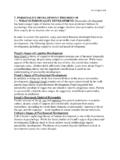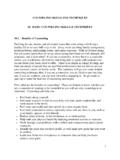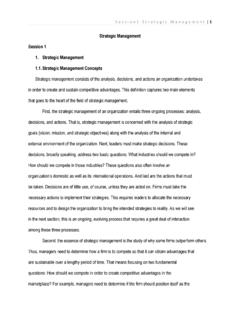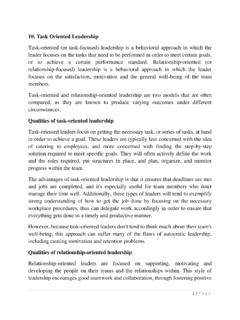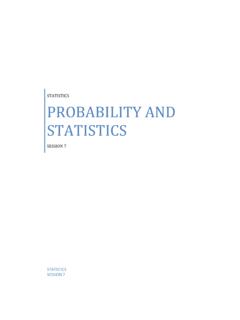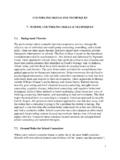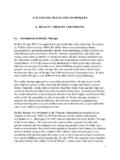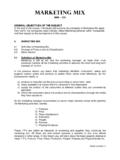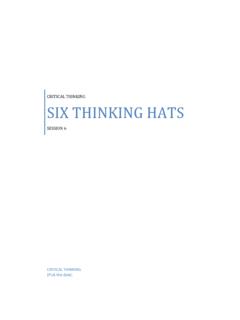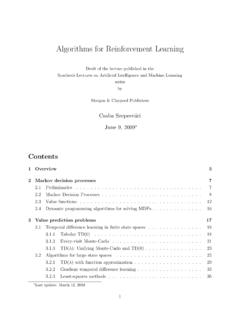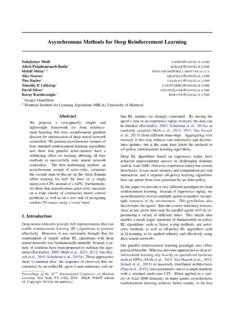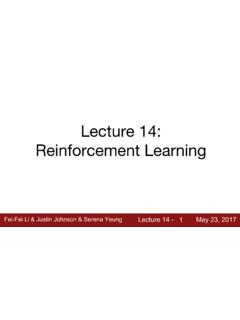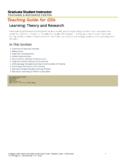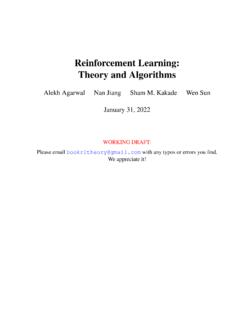Transcription of THEORIES OF LEARNING 2. BEHAVIORIST THEORIES 2.1 ...
1 1 THEORIES OF LEARNING 2. BEHAVIORIST THEORIES Behaviorism Overview Behaviorism is an approach to psychology that combines elements of philosophy, methodology, and theory. It emerged in the early twentieth century as a reaction to mentalistic psychology, which often had difficulty making predictions that could be tested using rigorous experimental methods. The primary tenet of behaviorism, as expressed in the writings of John B. Watson, B. F. Skinner, and others, is that psychology should concern itself with the observable behavior of people and animals, not with unobservable events that take place in their minds. The BEHAVIORIST school of thought maintains that behaviors as such can be described scientifically without recourse either to internal physiological events or to hypothetical constructs such as thoughts and beliefs.
2 From early psychology in the 19th century, the BEHAVIORIST school of thought ran concurrently and shared commonalities with the psychoanalytic and Gestalt movements in psychology into the 20th century; but also differed from the mental philosophy of the Gestalt psychologists in critical ways. Its main influences were Ivan Pavlov, who investigated classical conditioning although he did not necessarily agree with behaviorism or behaviorists, Edward Lee Thorndike, John B. Watson who rejected introspective methods and sought to restrict psychology to experimental methods, and Skinner who conducted research on operant conditioning. In the second half of the 20th century, behaviorism was largely eclipsed as a result of the cognitive revolution.
3 While behaviorism and cognitive schools of psychological thought may not agree theoretically, they have complemented each other in practical therapeutic applications, such as in cognitive behavioral therapy that has demonstrable utility in treating certain pathologies, such as simple phobias, PTSD, and addiction. In addition, behaviorism sought to create a comprehensive model of the stream of behavior from the birth of a human to their death. Behaviorism focuses on one particular view of LEARNING : a change in external behavior achieved through a large amount of repetition of desired actions, the reward of good habits and the discouragement of bad habits. In the classroom this view of LEARNING led to a great deal of repetitive actions, praise for correct outcomes and immediate correction of mistakes.
4 In the field of language LEARNING 2 this type of teaching was called the audio-lingual method, characterized by the whole class using choral chanting of key phrases, dialogues and immediate correction. Classical Conditioning Classical conditioning (also Pavlovian conditioning or respondent conditioning) is a kind of LEARNING that occurs when a conditioned stimulus (CS) is paired with an unconditioned stimulus (US). Usually, the CS is a neutral stimulus ( , the sound of a tuning fork), the US is biologically potent ( , the taste of food) and the unconditioned response (UR) to the US is an unlearned reflex response ( , salivation). After pairing is repeated (some LEARNING may occur already after only one pairing), the organism exhibits a conditioned response (CR) to the CS when the CS is presented alone.
5 The CR is usually similar to the UR, but unlike the UR, it must be acquired through experience and is relatively impermanent. Classical conditioning differs from operant or instrumental conditioning, in which a behavior is strengthened or weakened, depending on its consequences ( , reward or punishment). A classic experiment by Pavlov exemplifies the standard procedure used in classical conditioning. First Pavlov observed the UR (salivation) produced when meat powder (US) was placed in the dog's mouth. He then rang a bell (CS) before giving the meat powder. After some repetitions of this pairing of bell and meat the dog salivated to the bell alone, demonstrating what Pavlov called a conditional response, now commonly termed conditioned response or CR.
6 Ivan Pavlov provided the most famous example of classical conditioning. During his research on the physiology of digestion in dogs, Pavlov developed a procedure that enabled him to study the digestive processes of animals over long periods of time. He redirected the animal s digestive fluids outside the body, where they could be measured. Pavlov noticed that the dogs in the experiment began to salivate in the presence of the technician who normally fed them, rather than simply salivating in the presence of food. Pavlov called the dogs' anticipated salivation, psychic secretion. From his observations he predicted that a stimulus could become associated with food and cause salivation on its own, if a particular stimulus in the dog's surroundings was present when the dog was given food.
7 In his initial experiments, Pavlov rang a bell and then gave the dog food; after a few repetitions, the dogs started to salivate in response to the bell. Pavlov called the bell the conditioned (or conditional) stimulus (CS) because its effects depend on its association with food. He called the food the unconditioned stimulus (US) because 3 its effects did not depend on previous experience. Likewise, the response to the CS was the conditioned response (CR) and that to the US was the unconditioned response (UR). The timing between the presentation of the CS and US affects both the LEARNING and the performance of the conditioned response. Pavlov found that the shorter the interval between the ringing of the bell and the appearance of the food, the stronger and quicker the dog learned the conditioned response.
8 Example of Conditioned Stimulus (CS) and Unconditioned Stimulus (US) LEARNING is fastest in forward conditioning. During forward conditioning, the onset of the CS precedes the onset of the US in order to signal that the US will follow. Two common forms of forward conditioning are delay and trace conditioning. Delay conditioning: In delay conditioning the CS is presented and is overlapped by the presentation of the US. Trace conditioning: During trace conditioning the CS and US do not overlap. Instead, the CS begins and ends before the US is presented. The stimulus-free period is called the trace interval. It may also be called the conditioning interval. Operant Conditioning Operant conditioning (or instrumental conditioning) is a type of LEARNING in which an individual's behavior is modified by its antecedents and consequences.
9 Mechanisms of instrumental conditioning suggest that the behavior may change in form, frequency, or strength. The expressions operant behavior and respondent behavior were popularized by B. F. Skinner. The former refers to an item of behavior that is initially spontaneous, rather than a response to a prior stimulus, but whose consequences may reinforce or inhibit recurrence of that behavior. Operant conditioning is distinguished from classical conditioning (or respondent 4 conditioning) in that operant conditioning deals with the reinforcement and punishment to change behavior. Operant behavior operates on the environment and is maintained by conditioning of reflexive (reflex) behaviors which are also elicited by antecedent conditions, while classical conditioning is maintained by its antecedents and consequences.
10 Behaviors conditioned through a classical conditioning procedure are not maintained by consequences. They both, however, form the core of behavior analysis and have grown into professional practices. Table of Operant Conditioning Process Skinner is the person whose work is most often cited in connection with operant conditioning. To implement his empirical approach, Skinner invented the operant conditioning chamber in which subjects such as pigeons and rats were isolated from extraneous stimuli and free to make one or two simple, repeatable responses. Another invention, the cumulative recorder, produced a graphical record of these responses from which response rates could be estimated. These records were the primary data that Skinner and his colleagues used to explore the effects on response rate of various reinforcement schedules.
